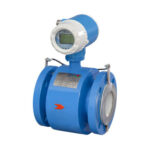ELECTROMAGNETIC FLOW METER

Electromagnetic Flow Meter Manufacturer and Supplier
An electromagnetic flow meter, often referred to as a magmeter, is a type of flow meter used to measure the flow rate of electrically conductive fluids, such as water, wastewater, slurries, and various chemicals. It operates on the principle of Faraday’s law of electromagnetic induction.
Here’s how an electromagnetic flow meter works:
- Electromagnetic Coil: Inside the flow meter, there are coils or electrodes positioned perpendicular to the direction of fluid flow. These coils generate a magnetic field.
- Conductive Fluid: As the conductive fluid flows through the meter’s pipe or tube, it cuts across the magnetic field lines. According to Faraday’s law, an electromotive force (EMF) is induced in the fluid. The strength of this EMF is proportional to the fluid’s velocity.
- Measurement of EMF: The flow meter measures the EMF induced in the fluid. This measurement is directly related to the flow rate of the fluid. By analyzing the EMF, the flow meter can calculate the flow rate in real-time.
Electromagnetic flow meters have several advantages:
- High Accuracy: They provide accurate measurements, even for fluids with varying electrical conductivity and conductivity. This makes them suitable for a wide range of applications.
- No Moving Parts: Unlike some other flow meters, electromagnetic flow meters have no moving parts in contact with the fluid. This reduces the risk of wear and tear, minimizing maintenance requirements.
- Wide Range: They can measure flow rates over a wide range, from low to high velocities.
- Bi-Directional Flow: Electromagnetic flow meters can measure flow in both directions, making them versatile for applications where flow can reverse.
- Minimal Pressure Drop: They typically have a low-pressure drop across the meter, which is important in systems with limited available pressure.
